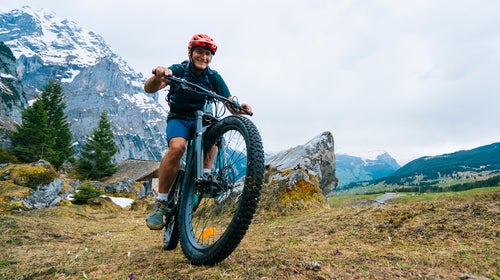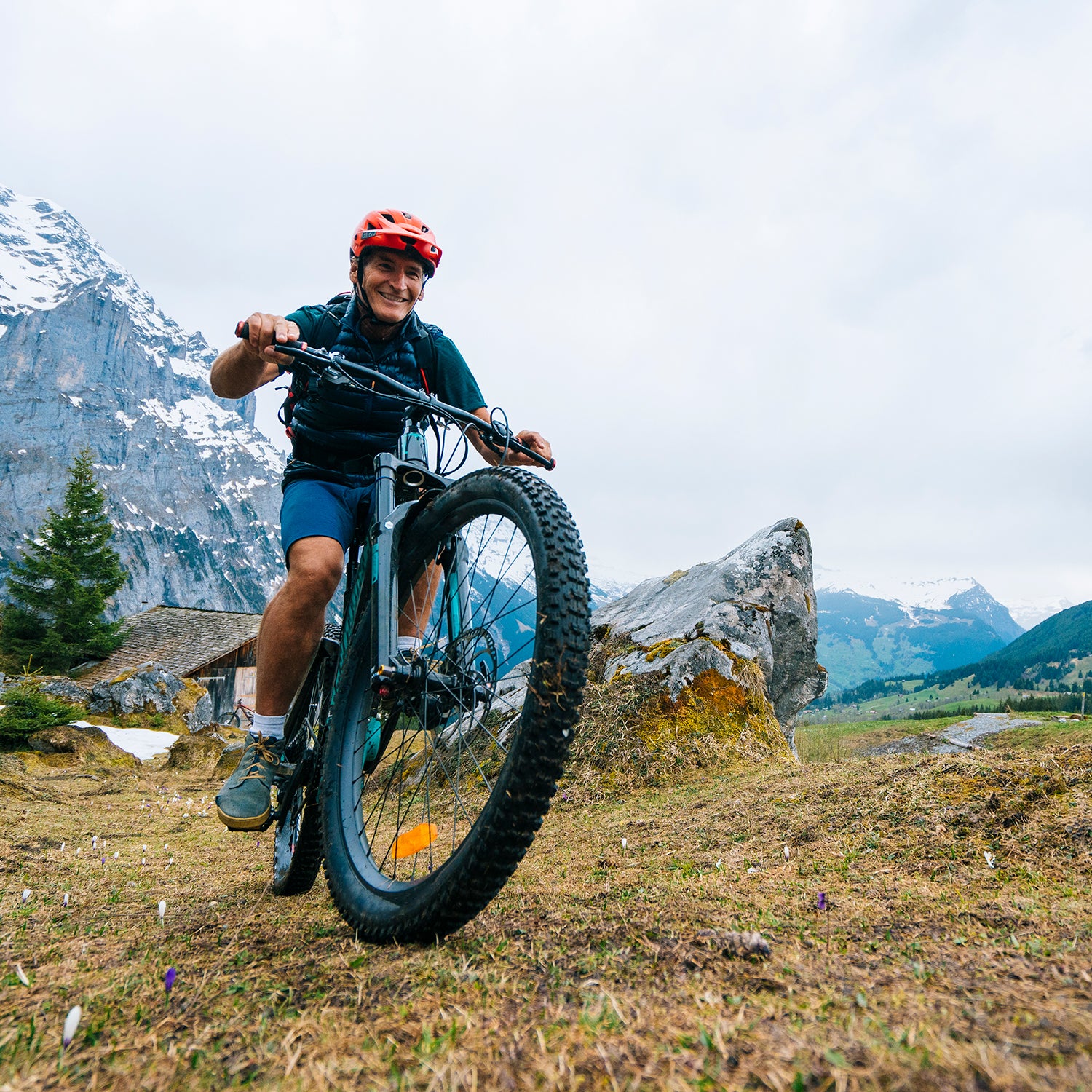I hate to tell you this, but your mountain bike probably doesn’t fit you.
If you bought a bike in the last five or so years, there’s a substantial chance that the frame is too big for you, your seat is too far forward, and the handlebar needs to be cut down or even replaced.
But bro! you spray at me from the tailgate of your lifted TRD Pro, You don’t even know me, bro!
You’re right. I don’t know you. I have never seen you on any bike, much less your current shred sled, which is of course totally dialed. And I have no idea just how hard you ride.
But here’s the thing: I’m probably still right. I know, because it almost happened to me too. It’s not really our fault. But if you won’t listen to me, listen to Lee McCormack.
McCormack is one of the foremost instructors in the sport, a Boulder, Colorado–based skills-book author, bike fitter, and coach with more than two decades of experience. He’s personally worked with, by his estimate, about 8,000 mountain bikers, ranging from total novices to World Cup downhillers. He’s also the creator of a fit system called that addresses what he sees as one of the central challenges of full-suspension bikes right now: they’re too big. Specifically they’re too big in a dimension known as reach, which is essentially the horizontal distance between the top of the headtube and an imaginary vertical line that runs through the center of the bottom bracket. “If you’re six foot four, then mazel tov, bikes finally fit,” he says. “But 90 percent of the people buying a new bike are on the wrong size.” Let’s say that’s overstated by half. It’s still an insane number of people on ill-fitting bikes.
How did it happen? Can it be fixed? And what the hell can you do about it if you already bought a bike?
How We Got Here
With the exception of cross-country race bikes, the modern trend in mountain-bike geometry is best summed up in a phrase you’ve likely seen in reviews: long, low, and slack. That’s shorthand for a longer reach and wheelbase, (sometimes) a lower bottom-bracket height, and a slacker headtube angle.��The geometry makes for bikes that are more stable when descending, particularly at high speed and in chunky, technical terrain. But it also means the size-mediums of today fit very differently from the mediums of a decade ago.��
Bike technology exists within a feedback loop involving the bikes, the riders, and the trails themselves. As suspension has gotten better, mountain bikers have moved on from four-wheel-drive roads and smooth singletrack to technical trails. They’ve ridden harder, putting new demands on bikes, which in turn have become more capable, and thus cyclists have moved on to ever more technical terrain. “It’s a spiral of evolution,” says Travis Brown, a member of the 2000 Olympic team who now runs mountain-bike research and development for Trek Bikes. “The product informs the riders and the riders inform trail development, and it cycles back on itself.”
For an example, look at the Sakura Drop, a five-foot-tall step-down that was of the Tokyo Olympic cross-country course. Although there was a less technical “B line,” almost every rider in both the men’s and women’s fields confidently hit the drop. Just 15 years ago, a jump like that would have been considered a legit feature on a .
According to Peter Zawistowski, director of engineering for Yeti, the change in wheel size on full-suspension bikes—from 26 inches to 29—was pivotal to the geometry shifts. In an effort to keep handling consistent with the larger wheels, designers realized they needed more trail to slow down the steering a bit, and they obtained it partly through slacker head angles. (Broadly, trail is the distance by which the front wheel’s contact patch trails��the steering axis.)
Even as those changes have created challenges for bike fit, “the reality is that bikes today are faster and safer,” says Barry Anderson, a biomechanist and lead fitter with boutique shop and fit studio, in Scottsdale, Arizona. Riders noticed, as did big brands, and now long, low, and slack is essentially the de facto geometry, especially in the trail and enduro categories that make up the vast majority of bikes sold.
Compare Yeti’s original 2012 trail 29er, the SB95, to the 2021 . They broadly share suspension designs and have identical wheel travel, but in a size medium, the SB130’s wheelbase is 65 millimeters longer (6 percent), the headtube is three degrees slacker, and trail is a whopping 30 millimeters greater. That increase in trail is a big part of what accounts for that stabler feel. Also consider Specialized’s platform. Over nine years, its wheelbase grew by 53 millimeters and its head angle got 3.5 degrees slacker. (For both brands, bottom-bracket height remained almost the same.)��
But the most notable shift is in reach, which grew 54 millimeters on the Yeti and 33 millimeters on the Stumpjumper (comparing size mediums). After less than a decade, the reach on Yeti’s medium SB130 is now longer than the XL SB95’s, and the reach on the medium modern Stumpjumper is longer than the old large’s. The change in reach is qualitatively different from shifts in metrics like trail, because it affects not only handling but also fit and sizing.
“For a long time, none of our bikes were big enough for me,” says Trek’s Brown. “I’m six foot two and always rode our largest size, and it was still not long enough. Then about ten years ago it got to a sweet spot, and the last few years I’ve been going down a size or two.”
If you haven’t adjusted your preferred frame size with the times, there’s a good chance that your bike is a little big for you, which will hurt your riding (and your body). Slack head angles and longer trail offer stability but can cause annoying front-wheel flop at low speeds, making technical climbs harder. If you’re dealing with a too-big bike, that’ll be even more pronounced. Long wheelbases are great for railing chunky sections without getting bucked around so much, but they suck at tight switchbacks and get bogged down in the kind of low-speed technical descending you find on the East Coast—problems that are also exacerbated if you’re wrestling with more bike than you need. Plus, a bike that fits poorly can lead to back and knee pain.
Fit Has Also Failed Mountain Bikers
Bike fitters rely on standardized methodologies��to dial in a customer’s most ergonomic riding position. Trouble is, those approaches are all drawn from road biking, so they prioritize power from a mostly static seated position and are appropriate for up- and downhill grades of about 10 percent. Mountain biking can involve grades three times that, Trek’s Brown points out. And while you do spend time seated, you also spend a lot of time in attack position: standing, knees and elbows bent, ready for the dynamic moves you’ll need on technical climbs and descents. But almost all bike fits are done in static positions on stationary trainers, explains Colby Pearce, an expert fitter who works with both road and mountain bikers. “For road fits, we have very clear metrics around comfort and power output and you can use techniques like motion-tracking [software] to look at joint angles,” he says. “But you can’t replicate mountain-bike handling on a trainer or import those values into the fit process.”
Because fit has largely ignored most mountain bikers, they return the favor. When I posted on Twitter asking what fitters people used for mountain-bike fits, I naturally got a string of reply-guys telling me that fit doesn’t matter for mountain biking because the position is dynamic. I’d argue that means fit matters even more, because as McCormack explains, the sport’s dynamic nature requires explosive power production and passable technical skills in multiple riding positions. Poor bike fit can get in the way of that.
This is where McCormack’s RideLogic comes in. It’s intended for all-around riders who want optimal handling, especially on technical terrain. Its primary aim is to position you on your bike so that you can ride with what McCormack calls heavy feet and light hands, steering and powering your bike from your lower body. This keeps your center of gravity low and stable, lessens the possibility of endos on techy descents, and reduces fatigue because you’re not using your upper body to muscle the bike around. McCormack also runs skills clinics, because a great bike fit alone is only the foundation for building up your technical abilities. “I realized I couldn’t separate body mechanics from riding technique,” he says. “And you can’t separate either of those from bike setup.” (One note: if you’re mostly a cross-country rider who stays on less technical terrain, a traditional fit, for all its shortcomings, may still be better.)
RideLogic relies on two key measurements that McCormack came up with. First is what he calls Rider Area Distance (RAD, get it?): the distance between the center of your bottom bracket and your handlebar steering center, just above the headset and slightly behind the stem clamp. It’s almost directly related to reach. The second is Rider Area Angle in Degrees (RAAD), which, crudely defined, is derived from your bike’s RAD and stack height, and it controls how upright your position is on the bike.
If your RAD is too short, your weight will be too far forward, which can lead to rear-wheel spinout on steep climbs, among other issues. Too long, and your arms will be almost straight, limiting your range of motion and making it harder to move the bike underneath you in technical terrain.
To find your RAD, prop your bike between two stepladders, picnic tables, or the like—whatever gets the bike a few feet off the ground so it can pivot freely around the bottom bracket. Set the bike between these props, balanced on both pedals with the cranks horizontal. In your riding shoes, stand on the pedals, grab the handlebars, and stand up as if you’re doing a deadlift. Ideally, if you’re standing with arms at full extension, the handlebar should rest at��your hips. If you have to uncurl your fingers to stand fully upright, your RAD is too short. If you have to bend your elbows to lift the bar to your hips, it’s too long. ’s Joy of Bike channel on YouTube covers it in detail; the basic on-bike approach is at 5:40.
McCormack finds that most people’s RADs are too long. The easiest, cheapest way to adjust RAD on a specific bike, McCormack says, is to swap stem lengths. If that’s not enough, you can also try stems with different extension angles, or handlebars with more sweep or narrower widths.��A wider reach to the grips has effects��similar to a too-long RAD, putting you at the limit of your range of motion. It may cause upper-body fatigue and pain. (A good starting point for bar fit places your elbows more or less behind your wrists when you’re in attack position.)
Once your RAD is close to ideal, RAAD is usually within a degree or two of optimal (there’s a calculator , which you can pay to use). For most trail bikes, he says, it should be between 58 and 60 degrees. Lee created other measurements he takes into account when doing a bike fit, like Steering/Hands Offset, but he considers RAD the key component.
What’s the Solution?
Bicycle geometry (to say nothing of fit) is devilishly complicated. For example, if you balance a bicycle with your hand and then give it a shove, it will roll upright for a surprising length of time, even re-balancing itself to some degree, before it slows and topples over. But we don’t know exactly why. As some from engineers Jim Papadopolous and Arend Schwab shows, it’s not the gyroscopic effect of the spinning wheels, or the caster effect of trail, or weight distribution, as much as it’s all these factors working together. Then add the presence of a rider. And to that, add a rider who, on a mountain bike, is moving dynamically over the bike as the bike itself moves over uneven terrain. The tl;dr: even bike-design experts don’t fully understand how bicycle geometry works, or what exactly leads bicycles to handle the way they do.
So is McCormack right about RideLogic? As with all things fit, there’s no single answer, but I think he’s onto something the industry is only starting to realize. For validation, he simply points to years of trial and refinement—spreadsheets, geometry charts, equations, and of course all those fit consultations with clients. When riding on technical terrain, McCormack says, “Your handlebar follows a specific path of rotation. It’s not mysterious. There must be an ideal distance between your hands and feet to allow that to work based on the size and proportions of your body.”
None of the fitters I spoke with were very familiar with his system, although all respect McCormack’s knowledge and agreed that existing, road-oriented fit methods aren’t really right for modern trail and enduro riding styles. A few questioned whether McCormack’s approach appropriately prioritized seated climbing, because RideLogic doesn’t start with saddle position. But McCormack contends it’s a non-issue. Seat height/setback and RAD/RAAD are independent of each other, he says; they’ll never be in conflict. If you have pain or complaints about your pedaling position, seek out a good traditional fit, then plug in your RAD and RAAD numbers to get the cockpit dialed. Finally, adds McCormack, do all that before you drop six large on a new bike.��
I’m a hopelessly average five-foot-nine rider with moderate handling skills. I love my medium Ibis Ripley, don’t get me wrong. And luckily, the RAD is close enough for my body that, with an with more backsweep, it works. On modern flow trails, the bike is a blast. But there are some trails I love that are more primitive, twisting and turning to hug spiky rock outcroppings and dense copses of trees where wide handlebars don’t fit. They’re technical, but not in the burly bashing-drops-and-rock-gardens style that’s popular now. And there, deep in those woods, I sometimes wonder if I’d be better off on a small.��
Bike fit and sizing are highly personal. They should comport with the rider’s size and riding style, the kind of bike, and the terrain. Zawistowski says that, while no one trail-bike��geometry will work for every rider, Yeti’s approach offers the best fit and handling it’s been able to create. But my sense, talking to others, is that it’s likely that the long-low-slack trend will begin to reverse a bit in coming years, at least on the mid-travel (120- to 130-millimeter) trail bikes. Even Trek’s Brown, who helps shape that brand’s direction, suggested that the long, low, and slack trend had gotten out of hand. “The whole thing became a paradigm where more was always better, and that got fossilized in the minds of the industry and riders,” he says. “And there are aspects of that that are not beneficial anymore.”
And if change does happen, I suspect that we might find that the bikes of the future, which are actually kinda like old bikes, ride pretty great. That while there are compromises, they’re modest and more balanced ones. Maybe, in this future bike world, you won’t need to be Richie Rude railing a rock garden at top speed to get full enjoyment out of your ride. Rude, a two-time Enduro World Series champion, is a key R&D resource for Yeti, where he’s helped develop the brand’s flagship race bike, the SB150. I should note that he’s almost six feet tall, a height Yeti’s Fit Guide puts on the cusp between a medium and a large for that bike. He rides a medium.


